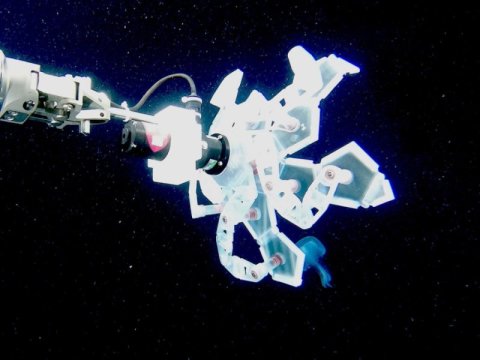[ad_1]
Scientists have tried to find the safest and most effective ways to explore marine life in the oceanic water, the largest and least explored environment on Earth, for years. Each time, they were faced with the same challenge: How to capture delicate or gelatinous pelagic animals — like jellyfish, squid, and octopuses — without harming them? A new device developed by researchers at Harvard University’s Wyss Institute, John A. Paulson School of Engineering and Applied Sciences (SEAS), Radcliffe Institute for Advanced Study and Baruch College safely traps delicate sea creatures inside a folding polyhedral enclosure and lets them go without harm using a novel, origami-inspired design. The research, co-authored by David Gruber, Presidential Professor of Biology and Environmental Science at the City University of New York’s Baruch College, is published in Science Robotics.
“We approach these animals as if they are works of art: would we cut pieces out of the Mona Lisa to study it? No — we’d use the most innovative tools available. These deep-sea organisms, some being thousands of years old, deserve to be treated with a similar gentleness when we’re interacting with them,” said Gruber who is also a 2017-2018 Radcliffe Fellow and National Geographic Explorer.
RAD (rotary actuated dodecahedron), designed for midwater interaction, is an innovative device that uses rotary-actuated folding polyhedrons to quickly and safely capture marine organisms. It consists of five identical 3D-printed polymer “pedals” that are attached to a series of rotating joints that link together to form a scaffold. The structure rotates at its joints and folds up into a hollow dodecahedron when a single motor applies a torque at the petals meeting point.
Zhi Ern Teoh, a former Wyss Postdoctoral Fellow, got the idea to apply folding properties to underwater sample collection in 2014. “I was building microrobots by hand in graduate school, which was very painstaking and tedious work, and I wondered if there was a way to fold a flat surface into a three-dimensional shape using a motor instead,” he said.
The RAD sampler design is perfect for the difficult and unpredictable deep ocean environment “because its controls are very simple, so there are fewer elements that can break. It’s also modular, so if something does break, we can simply replace that part and send the sampler back down into the water,” said Teoh. “This folding design is also well-suited to be used in space, which is similar to the deep ocean in that it’s a low-gravity, inhospitable environment that makes operating any device challenging.”
Teoh and Brennan Phillips, Assistant Professor of Ocean Engineering at the University of Rhode Island, are currently working on a more rugged version of the RAD sampler for use in heavier-duty underwater tasks, like marine geology, while Gruber and Robert Wood, Ph.D., engineer at Cooper Perkins, are focusing on further refining the sampler’s more delicate abilities. “We’d like to add cameras and sensors to the sampler so that, in the future, we can capture an animal, collect lots of data about it like its size, material properties, and even its genome, and then let it go, almost like an underwater medical check-up,” said Gruber.
Story Source:
Materials provided by The City University of New York. Note: Content may be edited for style and length.
[ad_2]















